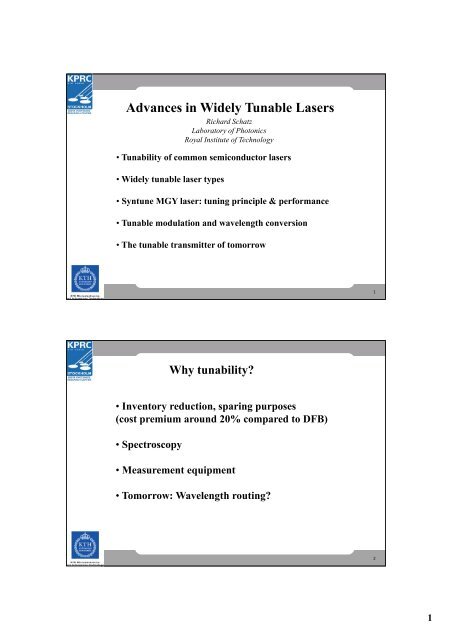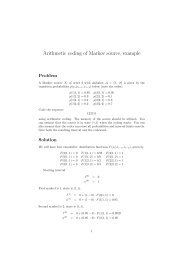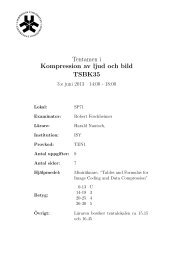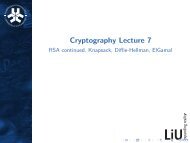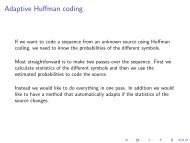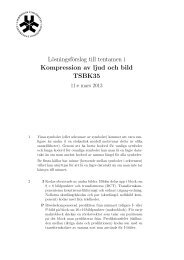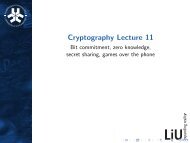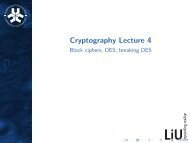Advances in Widely Tunable Lasers
Advances in Widely Tunable Lasers
Advances in Widely Tunable Lasers
You also want an ePaper? Increase the reach of your titles
YUMPU automatically turns print PDFs into web optimized ePapers that Google loves.
<strong>Advances</strong> <strong>in</strong> <strong>Widely</strong> <strong>Tunable</strong> <strong>Lasers</strong>Richard SchatzLaboratory of PhotonicsRoyal Institute of Technology• Tunability of common semiconductor lasers• <strong>Widely</strong> tunable laser types• Syntune MGY laser: tun<strong>in</strong>g pr<strong>in</strong>ciple & performance• <strong>Tunable</strong> modulation and wavelength conversion• The tunable transmitter of tomorrow1Why tunability?• Inventory reduction, spar<strong>in</strong>g purposes(cost premium around 20% compared to DFB)• Spectroscopy• Measurement equipment• Tomorrow: Wavelength rout<strong>in</strong>g?21
Common Semiconductor Laser TypesFPFabry-Perot+ very simple- multimodeDBR BDFBDistributedBraggReflectorDistributedFeed-Back+ s<strong>in</strong>gle mode+ electric tunability ~ 10 nm- two waveguide materials- two contacts+ simple- thermal tunability ~4 nm- <strong>in</strong>herently double modePS-DFBPhase-ShiftedDistributedFeed-BackVCSEL VerticalCavitySurfaceEmitt<strong>in</strong>gLaserTunability limited byΔλΔn≈ Γ < 1⋅10λn g−2+ s<strong>in</strong>gle mode- thermal tunability ~4 nm- more complicated than DFB- needs antireflection coat<strong>in</strong>g+ on wafer test<strong>in</strong>g: low cost- thermal tunability~2 nm-low power- difficult transverse s<strong>in</strong>gle mode- difficult >1.2 μm3DFB array<strong>Widely</strong> <strong>Tunable</strong> <strong>Lasers</strong>NTT (8 DFB)Fujitsu (8 DFB)Furukawa (12 DFB)Santur (MEMS-switch12 DFB)+ DFB technology+ stable λ- coupler loss- chip size- powe consumptionExternalcavitylaser<strong>Tunable</strong> mirror or filterIolon, Nec,Pirelli, Fujitsu,Intel+ tun<strong>in</strong>g range+ spectral properties- size- tun<strong>in</strong>g speed- modulation speedMonolithicDBR laserwith sampledgrat<strong>in</strong>gSG-DBRDS-DBRJDSU (Agility)BookhamSyntune+ monolitic (<strong>in</strong>cl. SOA &modulator)+ size+ tun<strong>in</strong>g speed+ power consumption+ control- electrically <strong>in</strong>duced- phase noiseMGY-laserJens Buus and Edmond J. Murphy, <strong>Tunable</strong> <strong>Lasers</strong> <strong>in</strong> OpticalNetworks,Journal of Lightwave Technology, Vol. 24, Issue 1, pp. 542
Modulated Grat<strong>in</strong>g Y-branch Laserfabricated by SyntuneWide tun<strong>in</strong>g by additive Verniereffect us<strong>in</strong>g two slightly differentmulti-peak reflectorsUpperLowerUpper reflectorMMILower reflectorCommonphaseGa<strong>in</strong>Frontfacet540 nm tunability with high side modesuppression ratio and output powerSMSR > 40 dBOutput power > 10 dBmPower variation < 1.5 dB withoutcompensation63
Direct Modulation vs ModulatorI bias +ΔI+I bias+ -V bias +ΔV+ Simpler+ Higher Output Power+ Inherently L<strong>in</strong>ear Modulation(Radio over fiber applications)+ Lower Chirp+ Higher Ext<strong>in</strong>ction Ratio+ Higher Modulation Bandwidth7Syntune S4500 C-band tunable 10 Gb/stransmitter• Monolithically <strong>in</strong>tegrated MGY+SOA+MZM• Full C-band tun<strong>in</strong>g (89 channels at 50 GHz spac<strong>in</strong>g)• 40dB SMSR• 4dBm output power•
Directly Modulated MGY-laser us<strong>in</strong>g chirpmanaged transmissionChirp adjusted so that azero cause a π phaseshift,”101” becomes ”10-1”→ dispersion tolerantExternal filter utilizes thechirp to enhanceext<strong>in</strong>ction ratioMatsui et al.,<strong>Widely</strong> <strong>Tunable</strong> Modulated Grat<strong>in</strong>g Y-branch Chirped Managed Laserpostdeadl<strong>in</strong>e ECOC 2009910 Gb/s over 200 km standard fiber us<strong>in</strong>g directmodulation and chirp managed transmission• 18 GHz bandwidthdt• Error free 10 Gbit/stransmission over 200 km• 10-18 mW output power atall wavelengths• 11-12 dB Ext<strong>in</strong>ction ratioMatsui et al.,<strong>Widely</strong> <strong>Tunable</strong> Modulated Grat<strong>in</strong>g Y-branch Chirped Managed Laserpostdeadl<strong>in</strong>e ECOC 2009105
<strong>Tunable</strong> wavelength conversion (1530-1560 to 1530-1560)at 10 Gb/s with MGY-laser <strong>in</strong>tegrated with SOASOA IFRGa<strong>in</strong>MMIRight reflectorCommonphaseLeft reflector•Utilis<strong>in</strong>g cross-ga<strong>in</strong> modulation <strong>in</strong> SOA•Conversion efficiency 20-70%•Collaboration with University of GhentChac<strong>in</strong>ski et al. OFC 200711Recent <strong>Advances</strong> <strong>in</strong> <strong>Widely</strong> <strong>Tunable</strong><strong>Lasers</strong>Richard Schatz• Tunability of common semiconductor lasers• <strong>Widely</strong> tunable laser types• Syntune MGY laser: tun<strong>in</strong>g pr<strong>in</strong>ciple & performance• <strong>Tunable</strong> modulation and wavelength conversion• The tunable transmitter of tomorrow126
Packaged DFB-laser <strong>in</strong>tegrated with Trawell<strong>in</strong>g-Wave Electroabsorption Modulator for 100 GbE• 100 Gb/s NRZ PRBS 2 31 -1• 0 dBm average power• 4.3 dB ext<strong>in</strong>ction ratio13Fiber DispersionDispersive fiberDistance ∝ 1/(Bitrate) 210 Gbit/s: 65 km40 Gbit/s: 4 km100 Gbit/s: 650 m!The solution?Adaptive dispersioncompensation needed butstill difficult to reach e.g. 65km with 100 Gbit/s!147
Radio Evolution vs Photonic Evolution1887Spark gapTransmitterOn-Offkey<strong>in</strong>g1903First arctransmitterwithcont<strong>in</strong>uosradio wavesFSK key<strong>in</strong>g1906First radiobroadcast ofvoice andmusicAMmodulation1914FirstcoherentradiotransmitterAMmodulation.1915FM stereoBroad-cast<strong>in</strong>g1918Superhetero-dynereceiver1961SSBmodul-ation1933FMmodul-ation.SubcarrierFMmodulation.1962First pulsed1970First CW1970First low loss1975First DFB1985-1989Research onsemiconductor semiconductor optical fiber s<strong>in</strong>glemode coherentlaser laser laser opticalreceivers1987First ErbiumdopedFiberAmplifierToday fiber-optic systems for telecom still utilize simple on-offkey<strong>in</strong>g and direct detection (Morse code and crystal receiver)15Radio systems today are the future for photonics1991199119941995199819982001GSMWiFiGPSDVBSADSLDVBTUMTS (3G)GMSKGaussianM<strong>in</strong>imumShiftKey<strong>in</strong>gOFDM orCCKOrthogonalfrequency-divisionmultiplex<strong>in</strong>gCDMACodeDivisionMultipleAccessQPSKQuadraturephase shiftkey<strong>in</strong>gDMTDiscretemultitoneOFDMwith QAMW-CDMANext generation optical transmission i systems will beadvanced digital radio systems at optical frequencies168
Use more advanced modulation formats!DQPSK, QPSK, QAM, OFDM, SCM, SSB...Higher spectral efficiency( lower modulation bandwidth for same bitrate)•Better tolerance to fiber dispersion•More wavelength channels per fiber (or higher bitrate forsame channel grid)•Lower bandwidth demands of electronics and photonics17Different carrier modulation formatsOOK PSK QPSK 16-QAM1bit/symbol 1bit/symbol 2bits/symbol 4bits/symbolPolarization multiplex yields another doubl<strong>in</strong>g of capacitywith<strong>in</strong> same WDM channel189
Optical QPSK system with Polarization Multiplex(one channel <strong>in</strong> a WDM system)Complex <strong>in</strong>tegratedoptical transmitters &receivers will be neededfor low cost!19Subcarrier modulation1-20 subcarriers, RF-generatedMulticarrier modulation formatsOptical CarrierOFDMOrthogonal FrequencyDivision Multiplex100-10000 subcarriers,digitally generated.Carriers orthogonal overbitslot200 THz±k . 10 GHzCDMACode Division Multiple AccessCarriers” consist of orthogonal digital code sequencies<strong>in</strong>stead of s<strong>in</strong>uses200 THz±k . 10 MHz2010
Optical Subcarrier System for 100GbE• Compare with ADSL modem for high speed data over telephone l<strong>in</strong>e• High demands on l<strong>in</strong>earity of modulator and detector• Integrated optical components needed for low cost21400km Transmission of 12.5 Gbit/sBaseband and DVBT on 45 GHz SubcarrierIP data<strong>Tunable</strong>LaserM-ZModulator0-10-20-30-40-501549.5 1550 1550.5 1551λSignal on fiber with IPdata <strong>in</strong> baseband andDVBT on subcarrierIP dataOther signal,e.g., DVBTMixerSubcarrier@ GHzFBGUpper sidebandfiltered out anddirectly detectedwith low speedPIN detectorλ BOther signal,e.g., DVBTFBGDispersion tolerant s<strong>in</strong>ce onlyone sideband is usedResidual lowersideband isfiltered away byreceiver filter2211
F<strong>in</strong>al conclusions• Monolithic 10 Gbit/s widely tunable lasers are today <strong>in</strong>tegrated withmodulators and manufactured at high volumes and low price• Monolithic devices offers fast tun<strong>in</strong>g


